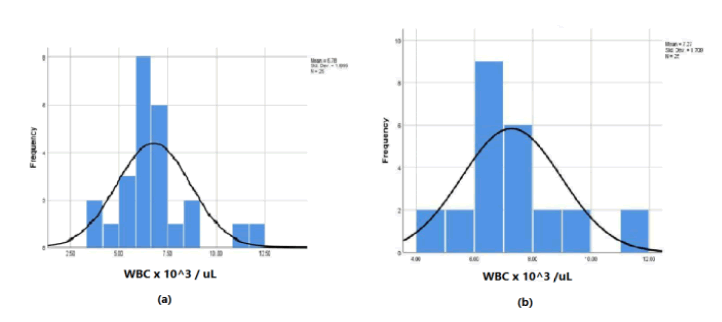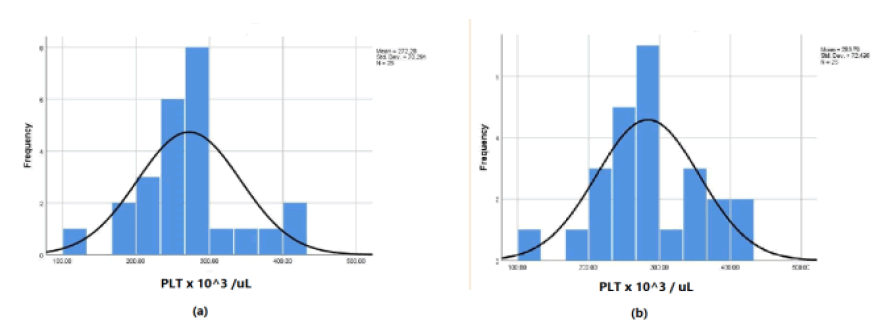Case Report - Onkologia i Radioterapia ( 2023) Volume 17, Issue 6
Effect of green Low-Level Laser (LLL) on the white blood cells and platelet of people with brain and prostate cancer
Esmaiel M Abdullah* and Aedah Z Al kaisyEsmaiel M Abdullah, Department of Physics, College of medicine, University of Baghdad, Baghdad, Iraq, Email: ismail.mohammed1208e@comed.uobaghdad.edu
Received: 14-Mar-2023, Manuscript No. OAR-22-91526; Accepted: 27-Mar-2023, Pre QC No. OAR-22-91526 (PQ); Editor assigned: 16-Mar-2023, Pre QC No. OAR-22-91526 (PQ); Reviewed: 19-Mar-2023, QC No. OAR-22-91526 (Q); Revised: 23-Mar-2023, Manuscript No. OAR-22-91526 (R); Published: 31-Mar-2023
Abstract
The effect of Low-Level Laser (LLL) provided by green semiconductor laser with an emission wavelength of 532 nm on of human blood of people with brain and prostate cancer has been investigated. The effect of LLL on white blood cell (WBC), NEUT, LYMPH and MONO has been considered. Platelet count (PLT) has also been considered in this work. 2 ml of blood sample were irradiating by a green laser of the dose of 4.8 J/cm2. The results suggest a potential effect of LLL on WBC, PLT, NEUT, LYMPH, and MONO of people with brain and prostate cancer.
Keywords
White blood cell, platelet, low-level laser therapy
Introduction
For more than 4 decades, LLL effects on human blood including modifications in structural and functional properties have been studied for various irradiation protocols with a broad spectral range (from near UV to near-infrared) and through different irradiation methods such as intravenous and transcutaneous blood irradiation [1,2]. LLL irradiation can cause many biological effects in living cells, such as blood, mostly via biochemical biomodulation rather than direct thermal effects [3]. Currently, LLL irradiation has widespread applications in different areas of medicine [4].
Laser parameters such as wavelength, energy, dose, and laser duration usually determine the photothermal effects of the laser on blood cells [5]. Such parameters should be chosen carefully because they have a strong relationship with their effect on tissues (blood samples), which can stimulate or inhibit physiological and biochemical processes [6]. Therefore, more research is required to understand the effects of these different parameters of LLL irradiation on human blood cells.
Since the effects of LLLT on the normal human blood have received huge investigations, almost there are no scientific reports about the effect of LLL on the blood of people with brain and prostate cancer.
The aim of the present work is to evaluate the effect of LLL on WBC and PL of human blood of people with brain and prostate cancer.
Case Presentation
A young woman came in an emergency with complaint of recurrent pain in the abdomen mostly the suprapubic area for about a week. There was no radiation or migration to other areas of the abdomen. She often complained about the difficulty in passing urine. No haematuria was reported. The patient denied any history of vomiting, jaundice and steatorrhea. Later the patient became febrile. On physical examination, the patient was an active woman with a good build and BMI. Her heart rate was 86 per minute, BP 110/76 mm of Hg, and temperature 38.0°C. On examination the abdomen was soft with a 3 cm sized tender swelling above the bladder. The blood counts, urinalysis, electrolytes, and renal function tests were found normal. Ultrasonography revealed a 2 cm × 15 cm sized lesion above the bladder. A Contrast-Enhanced CT scan (CECT) was done that confirmed a non-communicating urachal cyst between urinary bladder and anterior abdominal wall. The E. coli were grown in urine culture. The patient’s infection was successfully treated with parenteral amikacin.
Limitations of the Study
Some considerations and limitations regarding human blood components for patients or healthy persons under diagnosis with LLL should be taken into account. An example of this limitation is the number of lymphocyte cells where it has been found there is no specific number of lymphocyte cells that are necessary to keep the body healthy. This is because lymphocyte levels can change according to a person’s race, gender, location, and lifestyle habits. On the other hand, this kind of limitation or so-called threshold can vary between labs and people of different ages [7]. Other human blood components may undergo such these kinds of limitations.
Experimental
The blood samples of humans were collected from adult donors (15 females and 10 males) aged 20 years - 65 years. The protocol of this study was permitted by the research ethics committee in the Physiology Department, College of Medicine, The University of Baghdad, Baghdad, Iraq, and written agreements were taken from the donors. Blood samples have been saved in containers containing the anticoagulant EDTA then they have been divided into two groups. One group was a control, while the second group has been subjected to LLL provided by a semiconductor pointer laser with an emission wavelength of 532 nm. The dose of laser on the surface of the blood sample was 4.8 J/cm2 . The green diode laser pointer parameters used in this work are shown in Table 1.
Tab. 1. The green diode laser pointer parameters used to as a source of LLL.
| value | Parameter |
|---|---|
| 532 nm | Wavelength |
| 60 mW | Output power |
| CW | Laser operation mode |
| 2 cm | Laser diameter on the sample |
| 3.14 cm2 | Spot size |
| 19.1 mW/cm2 | Power density (irradiance) |
| 4.8 J/cm2 | Energy density (dose) |
Table 2 shows the normal blood parameters, and before and after applying LLL of dose of 4.8 J/cm2 on the blood samples for WBC, NEUT, LYMPH, MONO, and PLT.
Tab. 2. Laser effects on some blood components.
| Parameter | Normal range 103/µL | Before exposure | After exposure |
|---|---|---|---|
| WBC | 4.1-11 | 11.44 | 10.37 |
| NEUT | 1.5-7 | 7.98 | 6.32 |
| LYMPH | 1-3.7 | 2.3 | 3.41 |
| MONO | 0-0.7 | 1.15 | 0.5 |
| PLT | 150-400 | 295 | 235 |
Result and Discussion
Low-Level Laser restores health by removing the underlying causes of ill-health by decreasing inflammation, increasing oxygen and blood flow, promoting muscle calcium uptake, and increasing neurotransmitter release [8,9]. Laser light passes through the skin and stimulates the cells energy production centre, called the mitochondria, creating more energy, better cell communication, improved tissue growth, enhanced cell nutrition, and extended cell life [10,11].
In this work, the irradiated sample by LLL has received laser irradiation from the laser device whose parameters are listed in Table 1. The results demonstrated that the WBC count has decreased slightly reaching the value of 10.37 × 103/µL, this value falls into the normal range (4.1-11) × 103/µL, while the initial value of WBC is 11.44. Results also indicated that the lymphocyte count has been increased and Neutrophils after exposure to LLL, this because Low-Level Laser light stimulates cell receptors to increase cell energy production and any time one cell was stimulated to create energy, many other cells will also be stimulated to produce more energy. Improving cell proliferation, migration and prevention of cell apoptosis. LLL irradiation revealed shortterm effects on human blood cells involving changes in erythrocyte membrane which leads to the release of factors into the blood that appears to stimulate further changes, structural changes in plasma proteins, activation of complement and other components against foreign bodies, releases of oxygen free radicals, a decrease of platelet quantity and sometimes obstructing their functions, increased phagocytosis and many other effects [12] From the comparison between the numbers of mono count before and after irradiation, also the increasing in them count, plate late count after irradiated by Low-Level Laser light that because it stimulates cell receptors to increase cell energy production and any time one cell was stimulated to create energy, many other cells will also be stimulated to produce more energy [13,14].
Additional benefits of low level laser therapy include increased protein production, healthy cell growth, wound healing, circulation, tissue regeneration, and immunity. the laser light stimulates the original receptors the receptor stimulates non-laser cells triggering healing responses at the injury site. Histograms that provide graphical representations of the frequency distributions of WBC and PL are before and after exposure the blood sample to LLL are shown in Figure 1 and Figure 2 [15,16].
Figure 1: Histogram of WBC number (a) before applying LLL (b) after applying LLL
Figure 2: Histogram of PLT number (a) before applying LLL (b) after applying LLL
Conclusion
LLL has been applied on the normal human blood for different purposes and it has been shown that LLL had potential influence on the blood components. On the other hand, LLL may also have potential effect on the blood of people with different kinds of cancers.
References
- Siposan DG, Lukacs A. Effect of Low-Level Laser radiation on some rheological factors in human blood: an in vitro study. J Clin Laser Med Surg 2000; 18:185-95.
- Zhu R, Avsievich T, Su X, Bykov A, Popov A et al. Hemorheological alterations of red blood cells induced by 450-nm and 520-nm laser radiation. J. Photochem. Photobiol. B Biol, 2022; 230:112438.
- Mohseen HK, Madlum KN, Abd Jabbar H. Effect of Low Level Laser Irradiation on White and Red Blood Cells after Different Storage Periods.
- Shimoyama N, Shimoyama M, Mizuguchi T. Red and green low-powered He-Ne lasers protect human erythrocytes from hypotonic hemolysis. J Clin Laser Med Surg. 1991; 9:285-9.
- Zahra AT, Impacts of laser energy doses in maintaining the shape and deformability of the red blood cell (morphological &physiological) in vitro
Letters in Applied Nano Bioscience, 9;2020, 875 – 879. - de Oliveira MC, Krueger GF, Sganzerla JT, Gassen HT, Hernández PA et al. Effect of Radiotherapy and Low-Level Laser Therapy on Circulating Blood Cells of Rats. J. Lasers Med Sci. 2021;12.
- Zheng Y, Dong X, Chen S, He Y, An J et al. Low-Level Laser therapy prevents medication-related osteonecrosis of the jaw-like lesions via IL-1RA-mediated primary gingival wound healing. BMC Oral Health. 2023; 23:1-4.
- Hamblin MR. Low-level light therapy: photobiomodulation. Society of Photo-Optical Instrumentation Engineers (SPIE) 2018.
[Google Scholar] [Cross Ref]
- Lin JT, Recent Advances of Low-Level Light Therapy: Fun damentals, Efficacy and Applications, Res Med Eng Sc. 2018, 6, 657-660.
- de Freitas LF, Hamblin MR. Proposed mechanisms of photobiomodulation or low-level light therapy. IEEE Journal of selected topics in quantum electronics. 2016; 22:348-64.
- Chung H, Dai T, Sharma SK, Huang YY, Carroll JD et al. The nuts and bolts of Low-Level Laser (light) therapy. Ann. biomed. eng. 2012; 40:516-33.
- Kennelly PJ, Murray RK. White Blood Cells. Harper's Illustrated Biochemistry, 31e. New York: McGraw Hill; 2019.
- Mahdi SS, Aadim KA, Khalaf MA. New Spectral Range Generations from Laser-plasma Interaction. Baghdad Science Journal. 2021; 18:1328-37.
- Mahdi SS, Aadim KA, Khalaf MA. New Spectral Range Generations from Laser-plasma Interaction. Baghdad Sci. J., 2021 -; 18:1328-37.
- Abbas QK, Hassan LM. Antimicrobial Photodynamic inactivation of using Rose Bengal and Low-Level Laser Light against Staphylococcus aureus. Iraqi J. Laser, 2022;21.
[Google Scholar] [Cross Ref]
- Kareem R. PDF Cavity Disinfection Using Er, Cr: YSGG Laser Induced Photoacoustic Streaming Technique: Rand kareem Jassim Hussein Ali Jawad. Iraqi J. Laser. 2022; 21:41-7.



